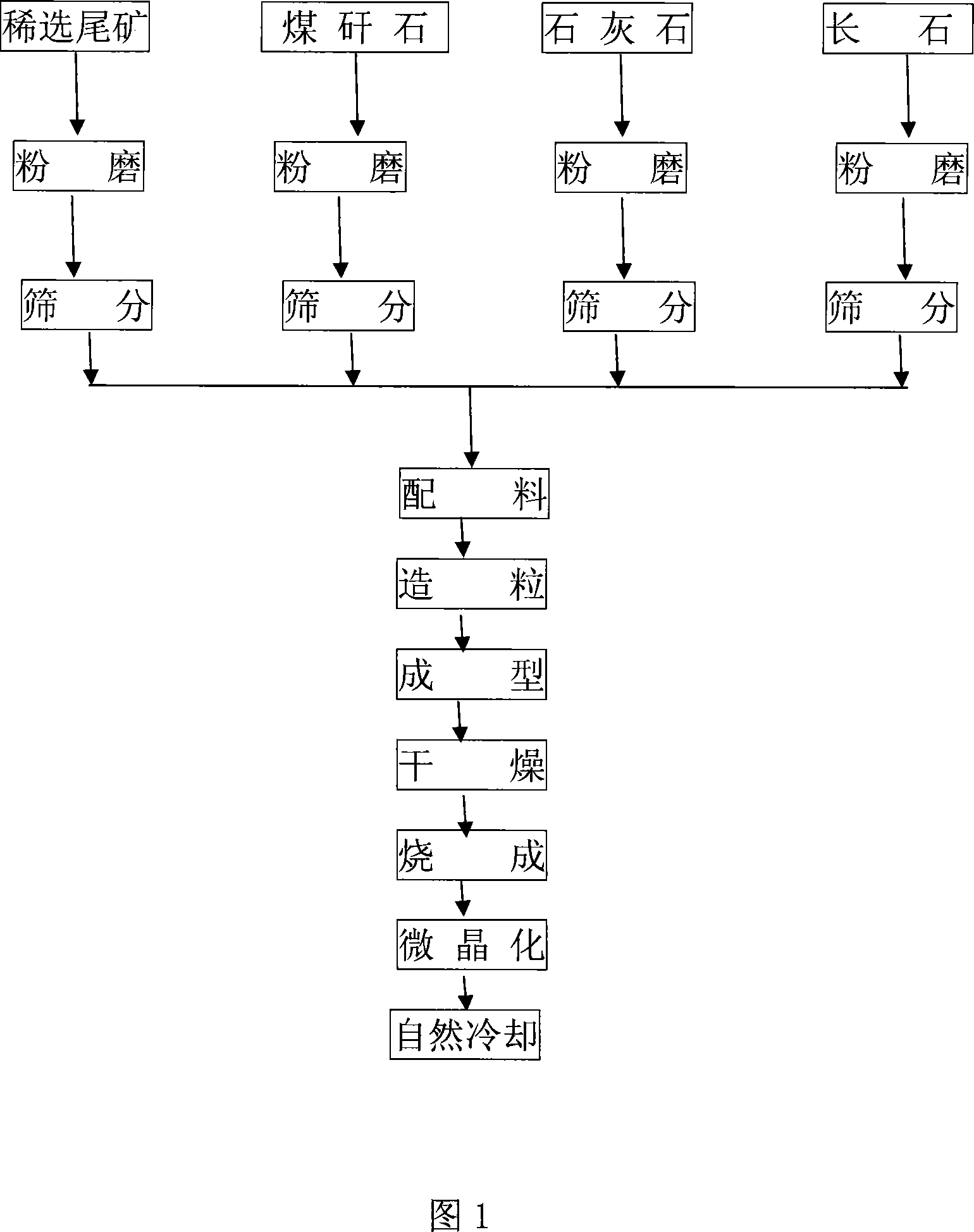Method for manufacturing glass-ceramics
A manufacturing method and technology of glass-ceramics, applied in glass production, etc., can solve the problems of secondary pollution and high production costs, and achieve the effects of eliminating pollution, shortening processing time, and reducing taxes
- Summary
- Abstract
- Description
- Claims
- Application Information
AI Technical Summary
Problems solved by technology
Method used
Image
Examples
Embodiment 1
[0025] The process flow is shown in Figure 1,
[0026] 1. Powder preparation
[0027] The rare earth tailings used are taken from Baotou Iron and Steel Rare Earth Plant. The chemical composition of rare earth tailings is shown in Table 1; the chemical composition of coal gangue is shown in Table 2; the chemical composition of feldspar is shown in Table 3. Weigh the rare earth tailings, coal gangue and feldspar according to the ratio of raw materials: balls of 1:2, and put them into the ball mill tank (the total volume of the charge should be less than 2 / 3 of the ball mill tank volume), and ball mill for 24 hours.
[0028] 2. Screening
[0029] The ball-milled rare earth tailings powder, coal gangue, and feldspar powdered raw materials are respectively passed through a 325-mesh sieve, and the prepared powder is placed in a powder bag for later use.
[0030] 3. Ingredients
[0031] The rare earth tailings powder: feldspar: coal gangue are respectively weighed in a weight ratio of 10...
Embodiment 2
[0042] The process flow is shown in Figure 1,
[0043] 1. Powder preparation
[0044] The rare earth tailings used are taken from Baotou Iron and Steel Rare Earth Plant. The chemical composition of rare earth tailings is shown in Table 1; the chemical composition of coal gangue is shown in Table 2; the chemical composition of feldspar is shown in Table 3. Weigh the rare earth tailings, coal gangue and feldspar according to the ratio of raw materials: balls of 1:2, and put them into the ball mill tank (the total volume of the charge should be less than 2 / 3 of the ball mill tank volume), and ball mill for 24 hours.
[0045] 2. Screening
[0046] The ball-milled rare earth tailings powder, coal gangue, and feldspar powdered raw materials are respectively passed through a 325-mesh sieve, and the prepared powder is placed in a powder bag for later use.
[0047] 3. Ingredients
[0048] The rare earth tailings powder: feldspar: coal gangue are respectively weighed in a weight ratio of 10...
Embodiment 3
[0059] The process flow is shown in Figure 1,
[0060] 1. Powder preparation
[0061] The rare earth tailings used are taken from Baotou Iron and Steel Rare Earth Plant. The chemical composition of rare earth tailings is shown in Table 1; the chemical composition of coal gangue is shown in Table 2; the chemical composition of feldspar is shown in Table 3; and the chemical composition of limestone is shown in Table 4. Weigh the rare earth tailings, coal gangue, feldspar, and limestone according to the ratio of raw materials: balls of 1:2, and put them into the ball mill tank (the total volume of the material should be less than 2 / 3 of the ball mill tank volume), and ball mill for 24 hours.
[0062] 2. Screening
[0063] The ball-milled rare earth tailings powder and limestone, coal gangue, and feldspar powdery raw materials are respectively passed through a 325-mesh sieve, and the prepared powder is put into a powder bag for use.
[0064] 3. Ingredients
[0065] The rare earth tail...
PUM
| Property | Measurement | Unit |
|---|---|---|
| flexural strength | aaaaa | aaaaa |
| compressive strength | aaaaa | aaaaa |
| flexural strength | aaaaa | aaaaa |
Abstract
Description
Claims
Application Information
 Login to View More
Login to View More - R&D
- Intellectual Property
- Life Sciences
- Materials
- Tech Scout
- Unparalleled Data Quality
- Higher Quality Content
- 60% Fewer Hallucinations
Browse by: Latest US Patents, China's latest patents, Technical Efficacy Thesaurus, Application Domain, Technology Topic, Popular Technical Reports.
© 2025 PatSnap. All rights reserved.Legal|Privacy policy|Modern Slavery Act Transparency Statement|Sitemap|About US| Contact US: help@patsnap.com

